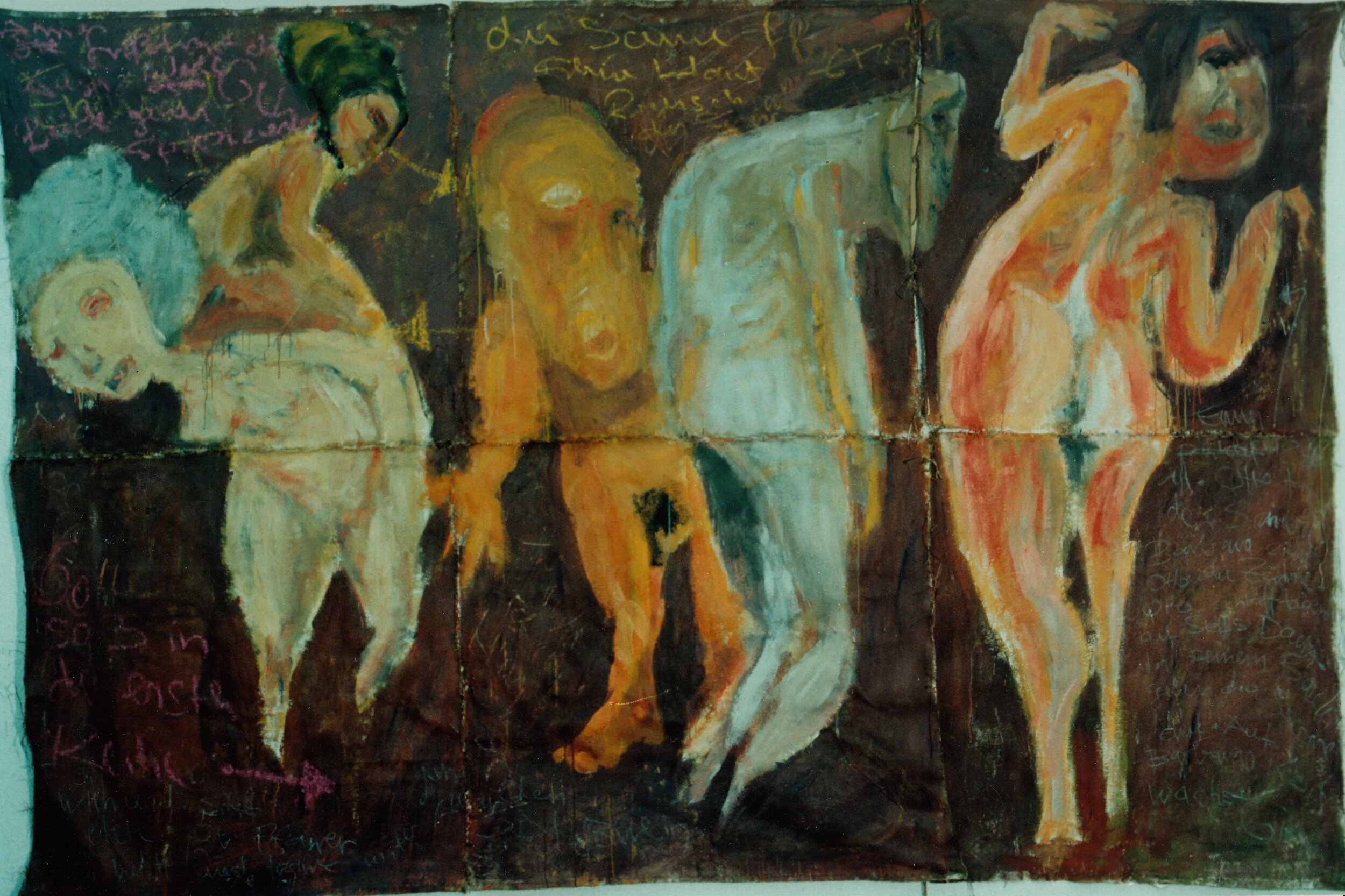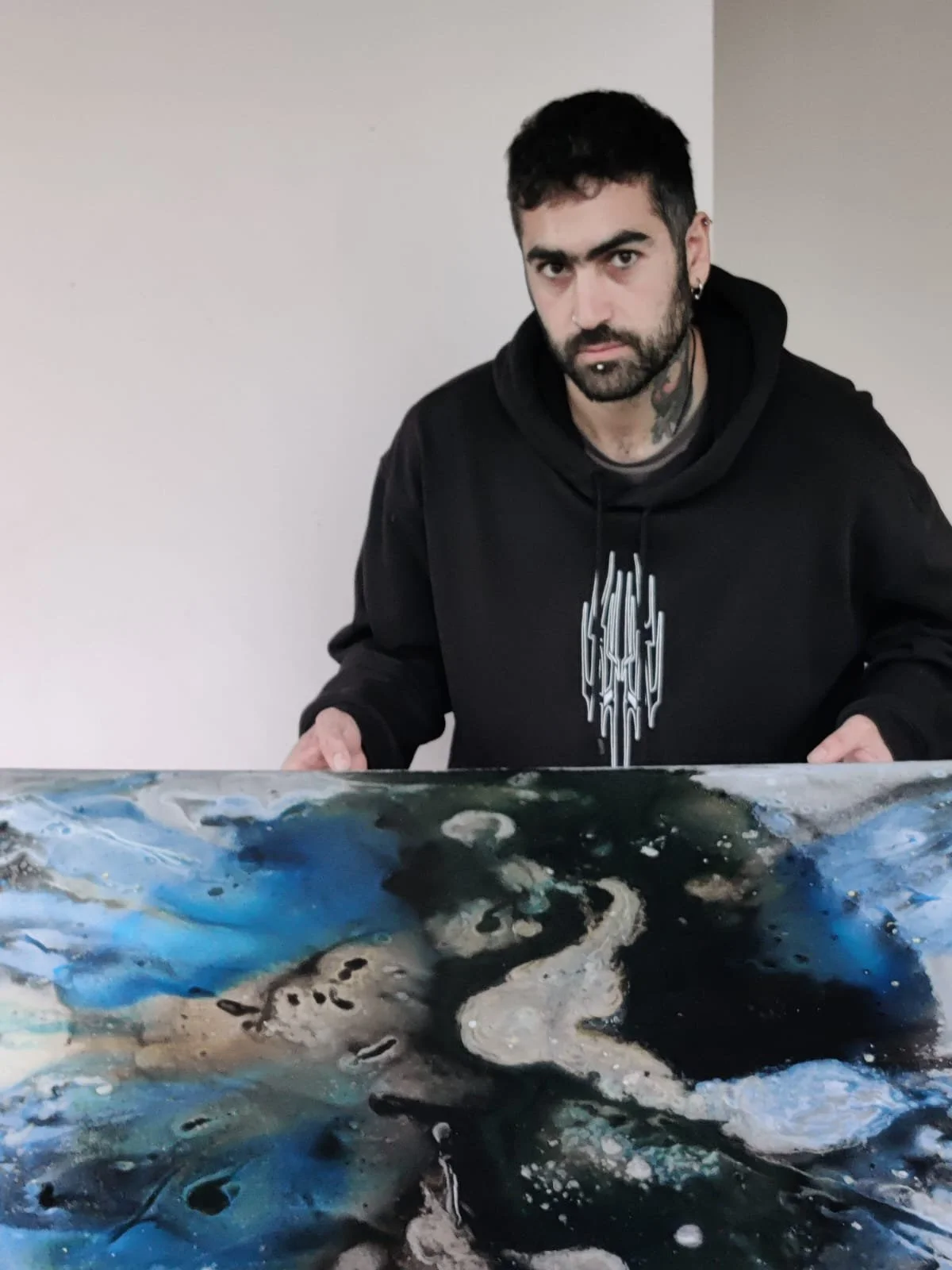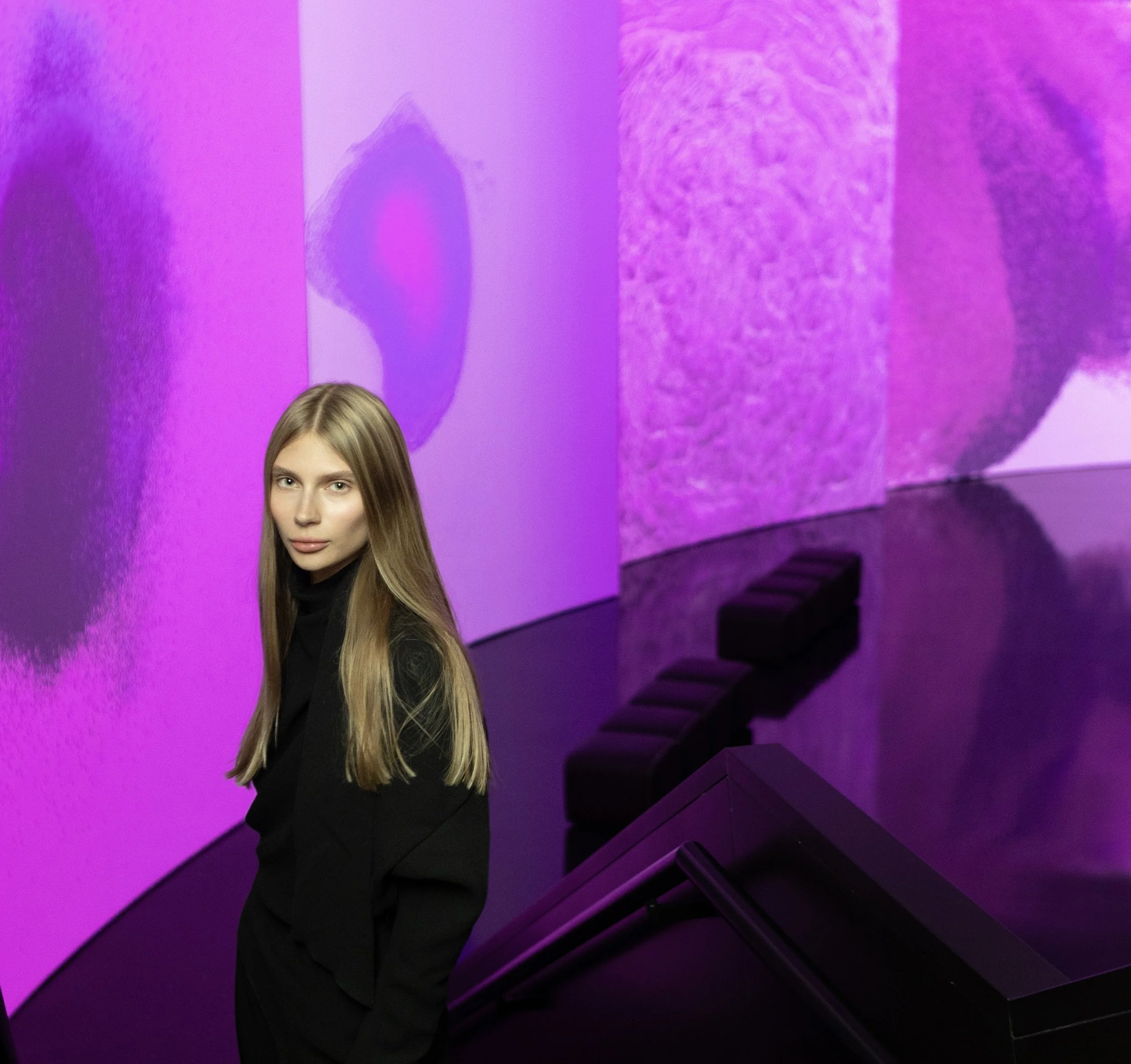10 Questions with Joas Nebe
Joas Nebe, who holds degrees in psychology and literature, is a self-taught artist, born in Hamburg but now located in South Germany. After a few years in Berlin, he decided to move south close to the French and Swiss border three years ago. Important exhibits include the artist's "Climate Change Cartoons "on display in the exhibition "Letters from the Sky" which accompanied the Durban UN conference on Climate Change 2011 in South Africa; "Machine Fair", a film about the mechanical side of a metropolis shown at the Museum of Modern Art, Moscow as part of "Now&After" screening in 2012. Other film works have been shown at 25th Festival Les Instants Video (Biblioteca Alexandrina, Cairo), Videoformes Festival 2014 and 2015, Sustain Our Africa, Madatac 3, 4, 5, 6 Competitive Official International Selection (Madrid), Papy Gyros Nights 2016 Hong Kong/ ART_TECTURE, In 24hours: Future Visions (SHIFT:ibpcpa) 2020, just to name a few.
Solo shows are "Intrude Art and Life" at the Museum of Modern Art, Shanghai in 2008, where Santiago Capriccio, a short epilogue to the Philosophical Cartoon cycle, was chosen to be one out of 100 non-Chinese artists to be displayed on public video screens in Shanghai for one day, 2016; "Encyclopedic", a one-night solo show at The Greenhouse, Berlin, 2016; "You Did A Bad Thing For A Good Reason", solo show at Berlin's Cormac Weiss Gallery, curated by Marinus Jo Dimitrov IFEA (International Curatorial Award 2016) supported by Christopher Grape Fund; 2017 "On Nature" at 16:9 Gallery, UTCL, the USA curated by Manzi Yang, 2020 The Palace Project, Online Fine Arts Museum, Argentine.
In 2017 Joas Nebe received an M 5 ARTS stipend for his video work "The Dictionary serial" (USA). The same year he has been awarded with the Residency by Correspondence from The Arts Territory Exchange Program, in 2018 with the Social Media Residency by Peripheral Forms, the Online Residency by Coldbench (all UK), the Social Media Residency by Open Call Artists by @boykeats/ Lu Gallagher (2020), ECUMENE Residence (2020), RUBB3R Collective Instagram Takeover Residency and Do It Your Way Instagram Takeover Residency (both 2021).
Joas Nebe's curatorial works have been shown in different European countries. He developed three projects to which international video artists contributed. "The Encyclopedic Cartoons Video Project" premiered in Berlin and has been shown in many European countries ever since. His second curatorial work, "the Proverb Picture Project" with participating artists from different continents and countries, premiered on VisualContainer TV in 2014. In 2017 Joas Nebe developed a project about democracy, scrabble, and wordlists, called "The Democracy Scrabble Project", which was presented again on VisualContainer TV and (.BOX) Video Project Room, Milan, in 2018.
In 2021, he received the audience award from the 1st International Conceptual Art Biennale in Latvia for his video work Hurricane Evacuation Route.
Joas Nebe portrait
ARTIST STATEMENT
"It's a never-ending game of disintegration. I challenge the viewer by not living up to his or her expectations. I am denying the satisfaction of solving the riddle, hidden within the depth of my artwork." By turning his film cabinet of curiosity into an intriguing jigsaw puzzle of hybrid geometric patterns, Joas Nebe teases the viewer into accessing his game. He believes that "Riddle games of this kind spark creativity and pass on the role of the artist to the viewer."
Limited edition art collectors’ book
INTERVIEW
You have a law background. Could you tell us a little more about your background and how did you begin making art?
In fact, my background is a little more diverse. I have been studying psychology, law, and media science.
My fascination with the arts began very early. I went to a private art school in Hamburg, where I studied painting, drawing, and printmaking when I was in school. By the time I made my general qualification for university entrance (Abitur), I was completely in love with painting. I used to paint big figures and groups of mostly naked people of all colors on huge canvases. Some figures seemed to come from mythology; others are like people I have been watching on the street of my birth town, Hamburg. Hamburg is a harbor city, and because of the harbor, the population is quite diverse. People from all nations live there—these people I pictured in my paintings, even the ones who lived on the streets.
What do you wish you knew about contemporary art before you got started?
I wish I understood at that time how artist careers are made by the global player galleries, such as Hauser and Wirth, Gagosian, etc. Today I know, they open galleries in cathedral-like buildings, made to overwhelm the audience, the latest Hauser and Wirth in a huge building on a small island in front of the coastline of Menorca. Suppose you take into account the representative building vibrancy. In that case, there is not much to do to make the artist presented in this "cathedrals of the art market" a great hero, a well-selling person, a more than successful artist. Of course, art market mechanisms are more complicated, and the pandemic cut away this selling parameter in some way for a certain time. Much has to be communicated via the internet, Zoom, etc. Maybe that's why NFT artworks of unknown artists are selling like hell.
House of Shades 2, 1998 © Joas Nebe
House of Shades 1, 1997 © Joas Nebe
Can you tell us about the process of creating your work? What aspect of your work do you pay particular attention to?
I find my expression, the translation of a concept, an idea independently from the format. Then I choose the format which fits best to the content. For example, the concept of the Room Project, which is creating a virtual non-existing place, where real-life experience, mental conditions, and emotions are mixed, wouldn't work in a painting because the fluidity, the permeability would be missed. A painting is always a kind of a frozen moment. Action has to be fixed to the climax to be communicated. A good example is Rembrandt van Rijn's Blinding of Simson, where the action is fixed shortly before the climax of the deed of blinding the protagonist.
During the last ten years, I have been mainly working with video because I could better express the issues I was interested in with this format. A big theme in the last years for me was how human beings communicate and how the medium of communication - language, images, audiovisuals - influences the content we want to communicate.
Where do you find inspiration for your work?
When I lived in Hamburg, Germany, I had a free entrance card to all fine art exhibiting museums in the city thanks to my member card of the artists' society (BBK). That was granted generously, and I used it to school my brain by watching the great painting and sculptures donated by the Hanseatic businessmen and women over the centuries who made the Kunsthalle collection possible, one of the biggest in Europe. The City of Hamburg never purchased anything. They only paid for the great museum in order to keep it working. So to say, I had a 20 years education of watching artworks during my time in Hamburg.
After leaving Hamburg, I spent five years in Berlin, and at that time, I visited the Gropiusbau, which developed interesting shows at least seen from the contemporary point of view.
Today I receive inspiration mainly from the web, and this will last a while until the pandemic is over.
You work with different mediums, what is your favorite and how do you approach the different mediums?
I am trained to work in different mediums. I attended an art school in Hamburg, where I learned about the different mediums. Additionally, I have been participating in directors' courses at the University of Hamburg for directors of opera and theatre, where I have learned to write and stage-manage my scripts. So my work is very diverse, and I am not limited to my video work, paintings, drawings, or everything else. I am still writing, although I never had the opportunity to publish anything.
I used to change between the mediums by deciding which is the right medium for my expression. Some expressions fit the writing (pandemic, the transformation of the medical treatment, etc.).
Other mediums are about how we feel as single individuals, as someone who is gaining a middle-age window with the clarity, the brightness, and the future impression. This is one of my issues today in painting with color ink and shellac. I am working on how the depiction of an individual portrait image and the abstraction of a human face might come together and merge into something new, beyond the dichotomy of natural and abstract.
Is there a piece you consider a "breakthrough" in your career?
My career's first "breakthrough "was creating the huge canvases, which were huge pieces of burlap unframed and stitched together with rope. I nailed the burlap canvases on the bare wall, and then I put white wall paint on them as subsurface, the wall paint you can buy in a hardware store. After that, I used big brushes to paint my big figures on that rough underground. In the 1990's I sold two of these paintings to one of the biggest entertainment firms in Europe, the van den Ende Stage Holding. The Stage Holding was taking over all musical theaters in Hamburg.
They insisted on turning the entrance halls of the musical palaces into big exhibitions of the local contemporary art scene, wherever they opened new theaters. And I was in the business with them. They bought two big burlap canvases, fixed them on the proper back support, a big wood board, and hung them in the 2000 square meter entrance hall of their harbor theatre in Hamburg together with other artworks from other artists. The entrance was guarded by Nikki de Saint Phalle's Nana sculptures. That was the first "breakthrough".
The second was in another genre. Between 2011 and 2019 I developed a new format in my video work, which I called "The Room Project". Before the pandemic hit our lives and destroyed our habits and reduced us to in-room-life-form, I maybe was foreseen this by creating virtual rooms, in which real-life experience, media communicated content, and the experience of being trapped in someplace is mixed.
I found this new format - as I used to call it - so inspiring that I am still working on it, coming from different issues. For example, the recent series of the Room Project I am developing at the moment is an interpretation of flower wallpapers and the experience of real nature flowers.
In June 2021, I received the Audience Award at Latvia's 1st Conceptual Art Biennale for my video work Hurricane Evacuation Route.
Painting, 250 x 300 cm, 1996 © Joas Nebe - VG Bildkunst bildkunst.de
Painting, 80 x 80 cm, 1995 © Joas Nebe - VG Bildkunst bildkunst.de
Painting, 250 x 250 cm, 1996 © Joas Nebe - VG Bildkunst bildkunst.de
Do you have a role model that you've drawn inspiration from when creating your art?
The great experimental artists were a great source of inspiration. For example, I love Jean Luc Godard's "WEEKEND", a film about an endless series of disasters caused by the motorized bourgeois people in France, spending their free weekend outside of Paris and causing uncountable accidents all around; but also Quentin Tarantino's "Pulp Fiction", a Movie about how dime novels changed the world of the US in the 1990s. Another one is Jonas Mekas's "Diary", a 16mm film document of his life in the US in a nearly surrealist way of using his Bolex at all possible occasions, even spelling his name in different languages in the 1970s.
Another source far away from the pictures is writers like Tchechow, writing about not coming into a move, always being fixed to the ground where the protagonists live, the province. They never would be able or even willing to leave for Moscow because of their lack of intent, although Moscow is the goal of their dreams. The big dilemma, the unexplained hiatus. The opposite of movement and development. The opposite of making movies.
Another source is the enigmatic author Luis Borges, the enigmatic inventor of the sealed library, which is invisible. "The Labyrinth" is about a person who gets lost in the endlessness of a library, as if climbing Mount Everest Massif upon the death zone and getting lost there.
What are you working on now, and what are your plans for the future? Anything exciting you can tell us about?
I am still working on the Room Project interpreting flower wall papers and the real-life experience of flower blossoms. I am going to the farmers market and buy flower bouquets, which I film and produce out of the stockage moving wallpapers in virtual rooms. You can imagine the result as standing in a room and watch the blossoms move around you everywhere you look. All four walls, the ceiling, and the floor are showing moving blossoms. It is a little like having a "trip". Everything is moving, although you are on your two feet and you don't move. But your brain makes you drift in an endless movement induced by the images around you—no place to position yourself. You are lost in the eternal movement, the life itself, which is eternal movement.
Flower wallpapers are an issue of the generation of flower kids, or at least those who never left their home to see the world, maybe the small bourgeoises. Flower wallpapers occur in different social classes. There are flower wallpapers in bourgeoise homes, even in aristocrats castles.
I am working on the interpretation of all these different social classes phenomena. And I am looking forward to producing a very interesting series of room-filling installations covering the four walls, the ceiling, and the floor with moving images
What do you wish to accomplish this year, both in terms of career goals and personal life?
The pandemic diminishes the expectations. I am one of the vaccinated the first time. A second vaccination is on the horizon in a couple of weeks. And then I hope to be able and allowed to travel again without restrictions. In these times it is even difficult if not impossible to visit the great museums.
If I consider my career, I have received at least one goal by being recognized with an Audience Award for my Room videos, the Hurricane Evacuation Route from the 1st International Conceptual Art Biennale in Latvia, 2021.
Finally, share something you would like the world to know about you?
My work is about the daily construction of the world around us, in our minds through interpretation of all kinds of information, e.g. audiovisual, tactile and semantical information, and interpretations of what we read on internet blogs, in the newspapers or TV, etc. They are non-bodily-information submitted to us by the originated web-based system.
We depend on the more or less wise interpretation of all this information to survive, survive in society, survive in the data jungle of the web, survive in nature, survive the vaccination, and survive relationships with other human beings. We are all meaning-miners always and every day. We depend on picking the right meaning out of the flood of information around us every day, always changing, because every day is different. We are constructing mental images of our surroundings, where information is a brick to what we are understanding, to build a new imaginary picture of what is around us and how we perceive it. This is a process that never ends because all things are always changing. Every brick is different, and a brick never will be the same brick, because bricks are the wrong image for being out there, being flooded by the information we are exposed to. The image of bricks is far way too static. So let's choose another image, symbol for what makes your daily life routine being anchored. Perception is multitasking and guided by what our brain tries to construct out of, what our senses and brains receive of information, and how we react to the demands of our surroundings and even the whole world.
And there is another aspect I am interested in. Every kind of information, e.g., language, images, film, even hearing, seeing, smelling, etc., has its own characteristics. These characteristics influence how we perceive certain things. For example, the same issue described through language will send you a different message as seen in a film or as smell or sound. So you will always receive an impression already manipulated by the sense or the format of information you are using.
This has to be considered when discussing the world's conditions, e.g., in a special religion or ideology. Because of this, I am very reserved for all kinds of belief systems. Because there is not one single meaning of what you are thinking about. Everything is opaque and always changing. And there will never be one explanation to a certain phenomenon, e.g., the condition of our society, the world.























